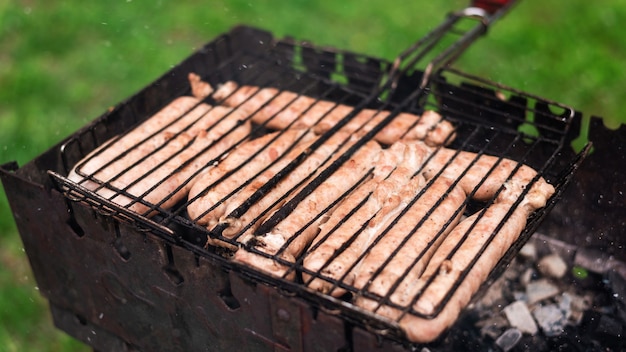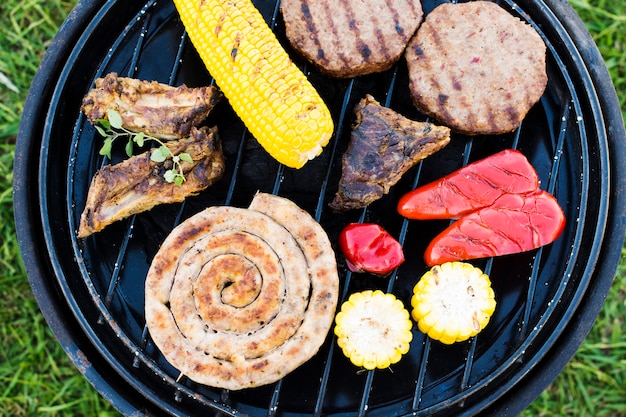Do you cook sausages on medium or high heat?
When it comes to cooking sausages, determining the ideal heat setting can be a subject of debate. Some prefer to cook them on medium heat, while others opt for high heat. In this article, we will delve into the factors influencing this decision and provide you with guidance on how to achieve the perfect sausage every time.
Understanding the Cooking Process
Before discussing the heat settings, it is important to understand the cooking process of sausages. Sausages are typically made from ground meat mixed with various seasonings and packed into casings. The cooking process involves both the internal and external components of the sausage.
The Low and Slow Approach
Cooking sausages on medium heat is often referred to as the “low and slow” approach. This method allows for a gradual cooking process, ensuring that the sausages are cooked evenly throughout. By cooking on medium heat, you reduce the risk of burning the exterior while the interior remains undercooked.
Benefits of cooking on medium heat:
- Even cooking
- Reduced risk of burning
- Retains juiciness
Considerations when using medium heat:
- Longer cooking time
- May result in less crispy texture
The High Heat Method
On the other hand, cooking sausages on high heat offers a different experience. The high heat method aims to achieve a crispy and caramelized exterior while ensuring that the inside is cooked thoroughly. It requires careful attention and a shorter cooking time compared to medium heat.
Advantages of cooking on high heat:
- Crispy texture
- Shorter cooking time
Points to note with high heat:
- Risk of burning if not monitored closely
- Potential for uneven cooking
- Possible loss of juiciness
Tip: For an extra burst of flavor, you can consider adding a little oil or butter to the pan when cooking sausages on high heat.
The Best of Both Worlds
While the heat setting may seem like an either-or decision, a combination of medium and high heat can be used effectively. This technique involves starting with medium heat to ensure even cooking and then finishing the sausages on high heat to achieve a desirable crispness.
Summary
Ultimately, whether you choose to cook sausages on medium or high heat depends on your personal preference. Medium heat offers even cooking and retains juiciness, while high heat provides a crispy exterior. Experiment with both methods to discover which one suits your taste buds the best. Remember to monitor the cooking process closely to avoid any mishaps, and enjoy your perfectly cooked sausages!
Is it better to cook sausages fast or slow?
When it comes to cooking sausages, there is often a debate about whether it is better to cook them fast or slow. The truth is, both methods can produce delicious results, but the technique you choose can affect the taste, texture, and juiciness of the sausages.
Faster Cooking:
Cooking sausages quickly over high heat can help to develop a crispy, caramelized exterior while keeping the inside juicy. This method is ideal for those who prefer a snappy skin and a slightly firmer texture. To cook sausages quickly, preheat your oven to 220°C (425°F) or heat a pan on high heat. Place the sausages in the oven or pan and cook for about 15-20 minutes, turning occasionally until they are browned and cooked through.
Slower Cooking:
On the other hand, slower cooking can result in sausages that are more tender and evenly cooked throughout. This method is perfect for those who prefer a softer, melt-in-the-mouth texture. To cook sausages slowly, preheat your oven to 150°C (300°F) or heat a pan on low heat. Place the sausages in the oven or pan and cook for about 30-40 minutes, turning occasionally until they are golden brown and thoroughly cooked.
Ultimately, the choice between cooking sausages fast or slow depends on personal preference. It’s worth experimenting with both methods to find out which one you enjoy the most.
“Cooking sausages fast or slow can produce different results, so it’s essential to consider what texture and taste you prefer.”
Comparison Table:
| Method | Advantages | Disadvantages |
|---|---|---|
| Fast Cooking | Crispy exterior, juicy inside | Slightly firmer texture |
| Slow Cooking | Tender, evenly cooked sausages | Softer texture |
Conclusion:
In conclusion, there is no definitive answer to whether it is better to cook sausages fast or slow. It all comes down to personal preference and the texture you desire. If you enjoy a crispy, caramelized exterior and a slightly firmer texture, opt for fast cooking. On the other hand, if you prefer a tender, melt-in-the-mouth texture, choose slow cooking. Don’t be afraid to experiment with both methods to find the perfect balance that satisfies your taste buds.
How hot should a BBQ be to cook sausages?
When it comes to cooking sausages on a barbecue, getting the right temperature is crucial for achieving that perfect golden brown crust while ensuring they are cooked through. The ideal cooking temperature for sausages on a BBQ is medium heat. This means having a grill temperature of around 350°F (175°C) to 400°F (200°C).
Determining the right temperature
To ensure your sausages are cooked evenly and thoroughly, you can use a meat thermometer. Insert the thermometer into the thickest part of the sausage, away from any bones or fillings. The internal temperature of a cooked sausage should reach a minimum of 160°F (70°C).
Note: It’s essential to preheat your barbecue grill for at least 10-15 minutes before cooking the sausages. This allows the grates to heat up evenly and prevents sticking.
The two-zone method for cooking sausages
One popular technique for cooking sausages on a BBQ is the two-zone method. This involves creating two separate heat zones on the grill: a hot zone for searing and browning, and a cooler zone for gentle cooking. Here’s how you can do it:
- Preheat one side of the grill to medium-high heat for searing the sausages.
- Leave the other side of the grill unheated or set to low heat for indirect cooking.
- Sear the sausages on the hot side of the grill for a few minutes on each side to get those beautiful grill marks.
- Move the sausages to the cooler side of the grill and continue cooking until they reach the desired internal temperature.
Tips for grilling sausages
Here are some additional tips to ensure your sausages turn out delicious:
- Prick the sausages with a fork before grilling to prevent them from bursting.
- Brush a light coat of oil on the sausages to prevent sticking and promote caramelization.
- Cook sausages slowly over medium heat to avoid drying them out.
- Let the sausages rest for a few minutes after grilling to allow the juices to redistribute.
Pro tip: If you’re unsure about the doneness of your sausages, you can always cut into one to confirm that it is cooked through.
Remember, achieving the perfect temperature while grilling sausages takes practice, so don’t be discouraged if it’s not spot-on the first time. With time and experience, you’ll become a BBQ pro!
Do you need oil to grill sausages?
Grilling sausages is a popular outdoor cooking method, especially during the summer months. While many people use oil to prevent sticking and add flavor, it is not always necessary. The answer to whether or not you need oil to grill sausages depends on personal preference and the type of sausages you are cooking.
Using oil for grilling sausages
Using oil can help prevent sausages from sticking to the grill grates, resulting in a more enjoyable grilling experience. It also adds a layer of flavor and can enhance the browning process. If you choose to use oil, remember to brush it lightly onto the sausages before placing them on the grill. Olive oil or vegetable oil both work well for this purpose.
Grilling sausages without oil
Grilling sausages without oil is entirely possible and can still result in deliciously cooked sausages. The natural fats in the sausages will render as they cook, providing sufficient lubrication to prevent sticking. However, it’s important to note that leaner sausages may benefit from a light brush of oil to prevent drying out or sticking to the grill.
Additionally, if you are using a non-stick grill or grilling sausages with higher fat content, such as pork sausages, the chances of sticking are significantly reduced, making oil unnecessary.
Factors to consider
When deciding whether or not to use oil for grilling sausages, consider the following factors:
- 1. Fat content: Higher fat content in the sausages reduces the need for oil.
- 2. Grill type: Non-stick grills may not require oil.
- 3. Personal preference: Some people prefer the added flavor and browning that comes with using oil.
“Whether or not to use oil when grilling sausages ultimately comes down to personal preference.”
So next time you fire up the grill for a sausage feast, consider whether you want to use oil or not. Experiment with different types of sausages and cooking methods to find what works best for you. Happy grilling!
Do you oil sausages before BBQ?
When it comes to barbecuing sausages, there are differing opinions on whether or not to oil them before grilling. Some people believe that adding oil to sausages can help prevent sticking and ensure they stay juicy, while others argue that it’s unnecessary and can result in flare-ups on the grill. So, should you oil your sausages before barbecuing?
The Case for Oiling Sausages
Proponents of oiling sausages before grilling argue that it helps create a crispy exterior while keeping the inside moist. The oil acts as a barrier between the meat and the grill grates, reducing the chances of the sausages sticking and tearing when you flip them. Additionally, the oil can enhance the flavor by helping the spices and seasonings adhere to the sausages.
“Oiling sausages before barbecuing can help achieve a deliciously crispy exterior while maintaining juiciness inside.”
The Case Against Oiling Sausages
On the other hand, those who prefer not to oil their sausages argue that the high fat content of most sausages is sufficient to keep them from sticking to the grill. Additionally, they caution against using too much oil, as it can drip onto the hot coals or burners, causing flare-ups and potentially charring the sausages. Some even claim that oiling sausages can hinder the natural casing from getting that desired snap.
So, what should you do?
In the end, whether or not to oil your sausages before barbecuing comes down to personal preference and the type of sausages you’re grilling. If you’re using leaner sausages or are concerned about sticking, a light brushing of oil can be beneficial. However, if you’re grilling higher-fat sausages, you may find that oiling them is unnecessary.
Here are a few tips to remember:
- If you choose to oil your sausages, use a neutral oil with a high smoke point, such as vegetable or canola oil.
- Apply the oil sparingly and evenly to avoid excess grease and flare-ups.
- Preheat the grill before adding the sausages to ensure even cooking and reduce sticking.
- Flip the sausages gently using tongs rather than piercing them with a fork to prevent the juices from draining out.
In summary, while oiling sausages before barbecuing can have its benefits, it’s not always necessary. Experiment with different methods to find what works best for you and enjoy your delicious grilled sausages!



